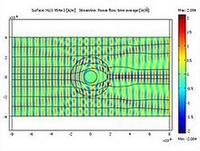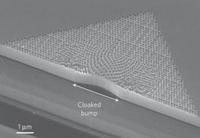-
CRITICAL MINERALSCritical Minerals Don’t Belong in Landfills – Microwave Tech Offers a Cleaner Way to Reclaim Them from E-waste
E-waste recycling focuses on retrieving steel, copper, aluminum, but ignores tiny specks of critical materials. Once technology becomes available to recover these tiny but valuable specks of critical materials quickly and affordably, the U.S. can transform domestic recycling and take a big step toward solving its shortage of critical materials.
-
-
Invisibility cloakInvisibility cloak closer to reality: Concealing military airplanes, and even people

Since the beginning of recorded time, humans have used materials found in nature to improve their lot. Since the turn of this century, scientists have studied metamaterials, artificial materials engineered to bend electromagnetic, acoustic, and other types of waves in ways not possible in nature. Now, Hao Xin, a professor of electrical and computer engineering at the University of Arizona, has made a discovery with these synthetic materials that may take engineers one step closer to building microscopes with superlenses that see molecular-level details, or shields that conceal military airplanes and even people.
-
-
EnergyNovel nanosized antenna arrays key to effective harvesting of solar energy
For years, scientists have studied the potential benefits of a new branch of solar energy technology that relies on incredibly small nanosized antenna arrays that are theoretically capable of harvesting more than 70 percent of the sun’s electromagnetic radiation and simultaneously converting it into usable electric power. A novel fabrication technique could provide the breakthrough technology scientists have been looking for to improve today’s solar energy systems.
-
-
Invisibility cloaksNew invisibility cloak conceals objects from human view

For the first time, scientists have devised an invisibility cloak material that hides objects from detection using light that is visible to humans; the new “carpet cloak” works by concealing an object under layers of silicon oxide and silicon nitride etched in a special pattern, and bending light waves away from the bump that the object makes, so that the cloak appears flat and smooth like a normal mirror
-
-
China syndromeChina establishes itself as a physics powerhouse
Published journal articles in nanoscience, with at least one co-author based in China, have seen a 10-fold increase since the beginning of the millennium, rising to more than 10,500 in 2007; China has already overtaken the United Kingdom and Germany in the number of physics papers published and is beginning to nip at the heels of the United States; the verdict on the quality of many of these papers is still out
-
-
Reasons for optimism over US particle physics
A panel of experts advising the U.S. Department of Energy says that recent cuts in funding for particle physics research may not do as much harm to U.S. basic research as scientists initially thought
-
-
New class of meterials offers many benefits
Microspheres to carry hydrogen, deliver drugs, filter gases, and detect nuclear weapons development
-
-
Advanced Nanotechnology Research, LANCER
Lockheed Martin and Rice University launch strategic partnership to develop center which will develop new technologies for a broad range of applications in electronics, energy, and security
-
-
New methods for detecting IEDs
Improvised explosive devices (IEDs) have exerted a painful toll on coalition forces in Iraq, and now in Afghanistan; DHS is worried that IEDs will soon make their deadly appearance on U.S. soil; Wolverines researchers offer a novel methods for detecting IEDs
-
-
TrendSteve Ballmer talks of "fifth computing revolution"
Microsoft’s CEO outlines the five pillars of the fifth computing revolution: Expanded processing power, huge amounts of storage, ubiquitous broadband, natural user interface (UI), and screens everywhere
-
-
On the water frontBacteria and nanofilters -- the future of clean water technology
University of Nottingham researchers combine contaminant-eating bacteria with nanoscale filtration membranes to purify fouled water; additional side benefit: The waste products created by purifying water have a very high calorific value, and can be used as fuel
-
-
On the water frontCleaner water through nanotechnology
As global warming causes more and more countries to have less and less fresh water for human consumption and irrigation, the purification and re-use of contaminated water becomes more urgent; Aussie researchers offer a nanotechnology-based method to purify water which is more effective and cheaper than conventional water purification methods
-
-
Nano-bristle clothes to generate power from body motions
Yellow Jackets researcher develops energy-generating fiber: If clothes are made from this piezoelectric fabric, the wearer’s body motions would produce useful amounts of power
-
-
Robots use electromagnetic force to create shape-shifting swarm
Carnegie Mellon researchers develop herds, or swarms, of robots using electromagnetic forces to cling to each other so they assume any shape or formation on the go; The prototype robots use electromagnetic forces to maneuver themselves, communicate, and even share power
-
-
NIST issues nanotechnology, biomedical standards
NIST issues its first reference standards for nanoscale particles targeted for the biomedical research community — literally “gold standards” for labs studying the biological effects of nanoparticles
-
More headlines
No headlines
